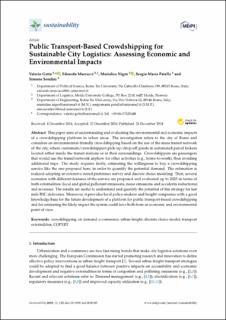| dc.contributor.author | Gatta, Valerio | |
| dc.contributor.author | Marcucci, Edoardo | |
| dc.contributor.author | Nigro, Marialisa | |
| dc.contributor.author | Patella, Sergio Maria | |
| dc.contributor.author | Serafini, Simone | |
| dc.date.accessioned | 2023-07-11T10:41:50Z | |
| dc.date.available | 2023-07-11T10:41:50Z | |
| dc.date.created | 2019-01-07T12:55:16Z | |
| dc.date.issued | 2019 | |
| dc.identifier.citation | Sustainability. 2019, 11 (1), 1-14. | en_US |
| dc.identifier.issn | 2071-1050 | |
| dc.identifier.uri | https://hdl.handle.net/11250/3077587 | |
| dc.description.abstract | This paper aims at understanding and evaluating the environmental and economic impacts of a crowdshipping platform in urban areas. The investigation refers to the city of Rome and considers an environmental-friendly crowdshipping based on the use of the mass transit network of the city, where customers/crowdshippers pick-up/drop-off goods in automated parcel lockers located either inside the transit stations or in their surroundings. Crowdshippers are passengers that would use the transit network anyhow for other activities (e.g., home-to-work), thus avoiding additional trips. The study requires firstly, estimating the willingness to buy a crowdshipping service like the one proposed here, in order to quantify the potential demand. The estimation is realized adopting an extensive stated preference survey and discrete choice modeling. Then, several scenarios with different features of the service are proposed and evaluated up to 2025 in terms of both externalities (local and global pollutant emissions, noise emissions and accidents reductions) and revenues. The results are useful to understand and quantify the potential of this strategy for last mile B2C deliveries. Moreover, it provides local policy-makers and freight companies with a good knowledge base for the future development of a platform for public transport-based crowdshipping and for estimating the likely impact the system could have both from an economic and environmental point of view. Keywords: crowdshipping; on demand; e-commerce; urban freight; discrete choice model; transport externalities; COPERT 1. Introduction | en_US |
| dc.language.iso | eng | en_US |
| dc.relation.uri | https://doi.org/10.3390/su11010145 | |
| dc.rights | Navngivelse 4.0 Internasjonal | * |
| dc.rights.uri | http://creativecommons.org/licenses/by/4.0/deed.no | * |
| dc.title | Public transport-based crowdshipping for sustainable city logistics : assessing economic and environmental impacts | en_US |
| dc.type | Peer reviewed | en_US |
| dc.type | Journal article | en_US |
| dc.description.version | publishedVersion | en_US |
| dc.source.pagenumber | 1-14 | en_US |
| dc.source.volume | 11 | en_US |
| dc.source.journal | Sustainability | en_US |
| dc.source.issue | 1 | en_US |
| dc.identifier.doi | 10.3390/su11010145 | |
| dc.identifier.cristin | 1651480 | |
| cristin.ispublished | true | |
| cristin.fulltext | original | |
| cristin.qualitycode | 0 | |

